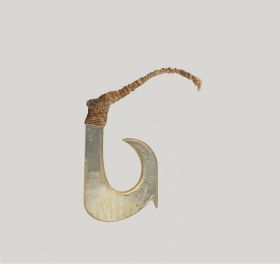Fishhook makau paweo
Place: Hawaii
Category: Fishing & hunting
mother-of-pearl, cord, Hawaii, l 4.2 cm, w (max.) 2.5 cm and 2.7 cm, Inv. Oz 225
Humphrey No. 274-275: ‘Two fish-hooks made of mother o’ pearl from Sandwich Isles.’
One of two fish-hooks that are made of mother-of-pearl. Oz 225 has a straight shank, that of Oz 226 is curved. A barb is located on the outer side of each fish-hook, directly below the point. The fishing line of Oz 225 is missing except for a small piece. A short brown fishing line is attached to Oz 226.
Hawaiian fish-hooks (makau) exhibit a great variety of form and size. The materials used for manufacturing them include shell, mostly mother-of-pearl (makau paweo), as well as dog bone (makau iwi ‘ilio), human bone (makau iwi kanaka), whale tooth (makau palaoa), tortoise shell (makau ea) and wood (Buck 1957: 324-28). To this list, Mitchell (1982: 149) added dog tooth (makau niho ‘ilio), bird bone (makau iwi manu), and whale bone (makau iwi kohola). Malo (1951: 79) named human bone, tortoiseshell, pig bone, dog bone, and mother-of-pearl shell as the materials used.
A possible classification of the makau is to distinguish between those made of one piece and those made of two. ‘Fish-hooks may be divided into simple hooks, made from one piece of material, and composite hooks, made of two pieces joined by a lashing’ (Buck 1957: 324). Emory, Bonk & Sinoto (1959: 7-11), however, introduced a new terminology. They classified the fish-hooks as ‘one-piece fish-hooks,’ ‘two-piece fish-hooks’ and ‘composite fish-hooks.’ Composite fish-hooks are those that are made of many different pieces, and which are more elaborate. The above authors argued that the two-piece fish-hooks, commonly called composite hooks, are in fact rather simple makau made of two parts. The fish-hooks which can be classified as composite are the bonito lure hooks and the octopus lure hooks, also called squid hooks (for the special materials and use of the various fish-hooks, see Buck 1957: 325-28).
Catching fish with hook and fishing line was just one of many methods that were practiced in Hawaii. Bare hands, spears, slip nooses, nets, and traps were also used (Mitchell 1982: 148f.). The fish supply remained constant, because the catching of a certain kind of fish was always restricted to a certain time of the year. Outside of this time it was declared kapu (prohibited). ‘The fish eaten during the summer months ... were different as to kind from those eaten during the winter’ (Malo 1951: 209). Fishing was the domain of specialists in Hawaii. They were called po’e lawai’a (fishermen), and were generally descended from families of fishermen. Certain religious ceremonies were associated with fishing. For these, special shrines were used (Malo 1951: 208; Mitchell 1982: 148). ‘The altar, a platform of stone ... on which the offerings were placed, was called the ko’a’ (Mitchell 1982: 151). Inken Köhler
Sources
Buck, Peter, Arts and Crafts of Hawaii, Honolulu, 1957.
Emory, Kenneth P, Bonk, William J and Sinoto, Yosihiko H, Hawaiian Archaeology: Fishhooks, Bernice P Bishop Museum Special Publication 47, Honolulu, 1959.
Malo, David, Hawaiian Antiquities (Mo’ olelo Hawai’ i), Nathaniel B Emerson (trans.), Bishop Museum Special Publication 2, Honolulu, [1839] 1951.
Mitchell, Donald DK, Resource Units in Hawaiian Culture, Honolulu, 1982.
Related artefact
Fishhook makau paweo, Inv. Oz 226

